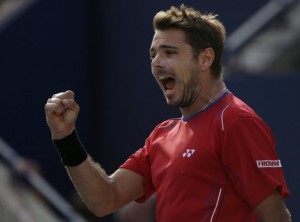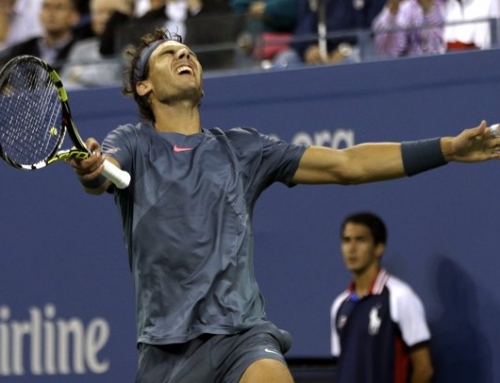 Andy Murray would have you believe, in his press conferences, that he was playing pretty well, but even the reporters knew he wasn’t. Such is the self-delusion pro players must have to keep themselves from falling into a pit of despair. Roger Federer was famed for this attitude. Sure he won 7-6, 7-6, but he never dropped serve, right? He also never broke serve either. That’s a danger sign.
Andy Murray would have you believe, in his press conferences, that he was playing pretty well, but even the reporters knew he wasn’t. Such is the self-delusion pro players must have to keep themselves from falling into a pit of despair. Roger Federer was famed for this attitude. Sure he won 7-6, 7-6, but he never dropped serve, right? He also never broke serve either. That’s a danger sign.
The early round scores would indicate comfortable wins, right? Leonardo Mayer: 7-5, 6-1, 3-6, 6-1. Florian Mayer: 7-6 6-2 6-2. These are decent scores, no? Yes, to the untrained eye, they are decent scores, but there were worrying signs.
First worrying sign: first serve percentage. Rather than operate in the lofty realm of 60% (lofty for the Scot, that is), Murray was slipping under 50% first serves. Normally, Murray doesn’t fret because he doesn’t lose so many points on second serve, but his second serve has always been slower than women’s second serves (albeit with far more spin). On a good day, Murray might crack 80 mph on average, but usually it’s below that. It’s been a weakness forever, and it doesn’t look like it’s getting any better.
Second worrying sign: unable to hit winners with any regularity. When Murray last challenged Djokovic at Wimbledon, he opted for a grinding style of play. Hit hard, but hit safe. Don’t go for winners. Let Djokovic go for it or make a mistake. Occasionally, he’d rip a good shot.
However, the last few matches, most attempts by Murray to hit a winning shot met with error. Just a little wide here, just a little deep there. So Murray had to resort to hitting shots up the middle and grinding. This worked well for the caliber of players he was playing, but surely, even Murray knew that he was waiting for errors, and not controlling the points.
Third worrying sign: Murray was lagging deep behind the baseline. For years, Murray preferred the comfort of playing deep behind the baseline. By playing that far back, and by not having either the precision hitting of a Djokovic nor the high-kicking topspin of a Nadal, Murray was often left scampering around, fetching shots like an eager terrier. Unlike the other “big 4”, Murray’s old habits were to let the other players dictate shots against him, but use his immense speed and anticipation to hit miracle shots or wait for the error.
Lendl had worked hard to get Murray to stay closer to the baseline, to stay in control of the point, and Murray listened, but it must have been like telling someone that loves bacon and sausage that they need to be vegetarians eating apples and carrots. It’s distinctly uncomfortable and unsatisfying. So when things went wrong, Murray went back to his old style like a security blanket.
Fourth worrying sign: Murray was back yelling at himself. Murray considers himself something of a perfectionist. Many people (well, mostly guys) find that if they yell at themselves enough, then they are punishing the person before anyone else does. They feel better about berating themselves. But this is usually a danger sign for a player like Murray because it means he isn’t playing to the level he wants to be. All that yelling rarely produces better tennis. Furthermore, whether he likes it or not, it alienates him from the audience. Federer was on his own error-fest against Robredo, but was he yelling at himself? Different strokes, perhaps.
Fifth worrying sign: things weren’t getting better in the later rounds. Sometimes you’ll see a player, like Nadal, who starts off patchy in the early rounds. They make mistakes. They are struggling with control. By the second week, you know they will fix up their problems, and get in a groove, and things will be good. Nadal wasn’t quite in a funk, but his play has gotten better and better, and he’s looking great in the second week.
Murray? His play seemed mired in ordinary. Those winners he was going for (and missing) in the second round? He was still missing them in the fourth round. His play wasn’t any better in the fourth round than the second. That was worrying because his opponents were only going to get better.
Now some have said that after all those years of toiling, trying to win that Slam, once he won the US Open, then Wimbledon, the source of motivation dried up. He didn’t come into the US Open feeling he had anything more to prove, and he didn’t come in that prepared. Murray is a moody person by nature. He lacks the easy-going nature of Djokovic who loves the celebrity, but is willing to work hard. He lacks Nadal’s ability to be the best and hone a shot that he can hit to the sidelines in a windstorm.
Meanwhile, let’s get to Stan Wawrinka. As Murray was winning a four setter against Istomin (which only went to 4 sets because Murray couldn’t hit key shots in the tiebreak despite being under control of the tiebreak), Wawrinka was playing another hot, dangerous player, Tomas Berdych. He was using his patience mixed with power to handcuff the mighty Czech.
Berdych hits with power, but he needs to, so he can cover up his foot speed issues. Wawrinka was able to move Berdych around, yet withstand the power.
Wawrinka played plenty aggressive against Murray, and even in close games, he kept pressuring Murray. Murray, meanwhile, due to the problems he had been having, was unable to withstand an in-form Wawrinka.
It must feel plenty strange for Wawrinka to be the Swiss player that has made it furthest in the tournament. His ranking has come back up so that he’s now a top ten player once again, and he’s beaten Murray before (back in 2009) at the US Open.
As good as Wawrinka played–and he did play well–Murray wasn’t ready to defend his title, and there were signs of this in the past three rounds.





![[US Open Men’s Final] Can Djokovic beat Nadal in the finals?](https://www.essentialtennis.com/wp-content/uploads/2013/09/20130909djokovic-500x383.jpg)
![[US Open, Semis] Djokovic and Nadal to play US Open final once again](https://www.essentialtennis.com/wp-content/uploads/2013/09/20130907nadal-500x383.jpg)
![[US Open, Day 10, QF] Nadal shuts out Robredo to reach semis](https://www.essentialtennis.com/wp-content/uploads/2013/09/20130905nadal-500x383.jpg)